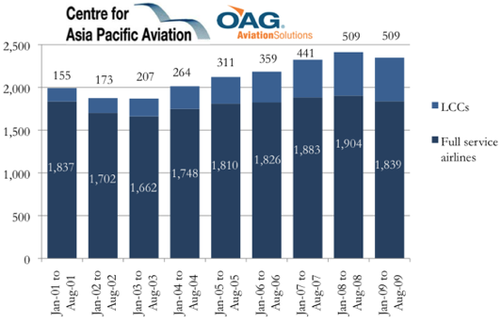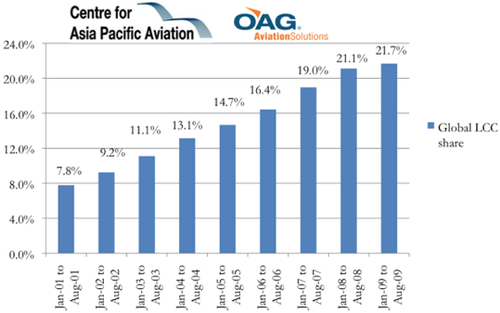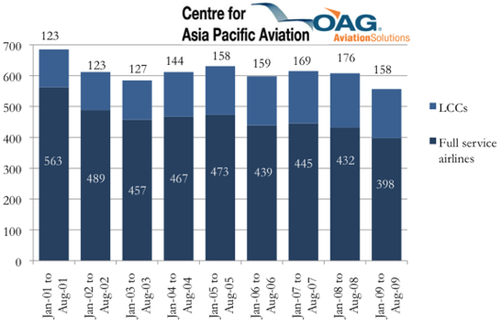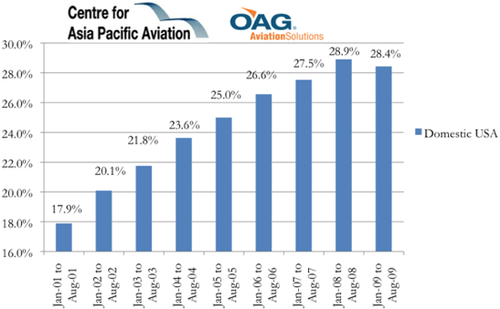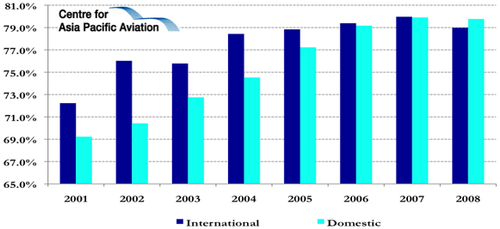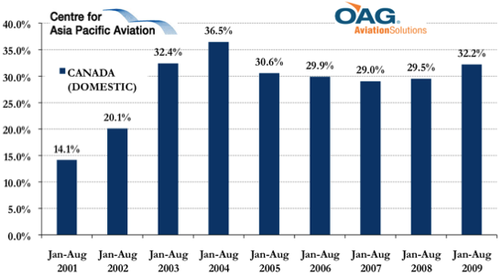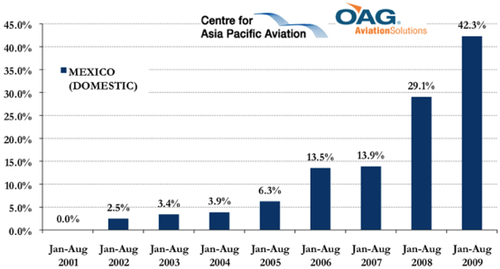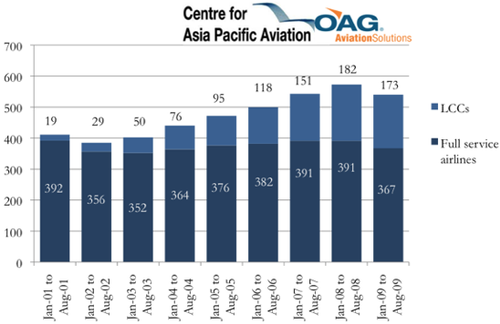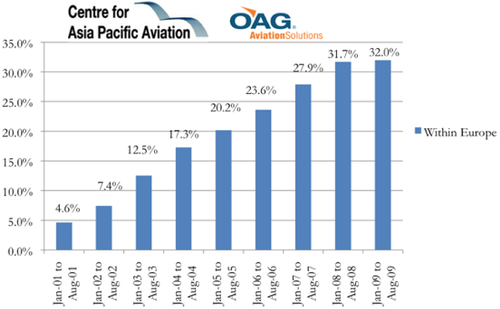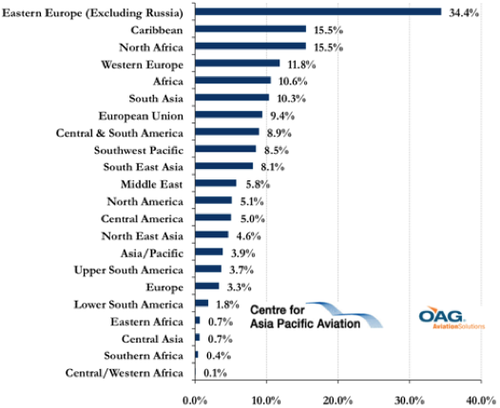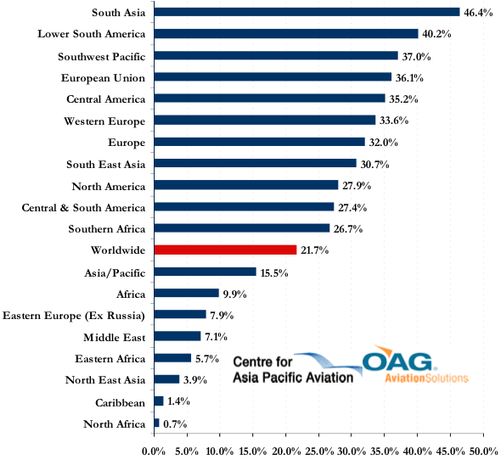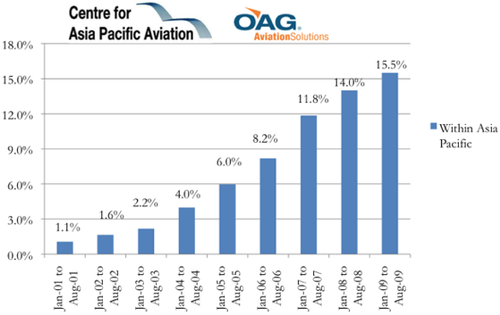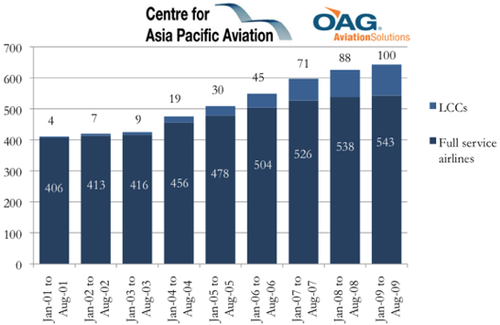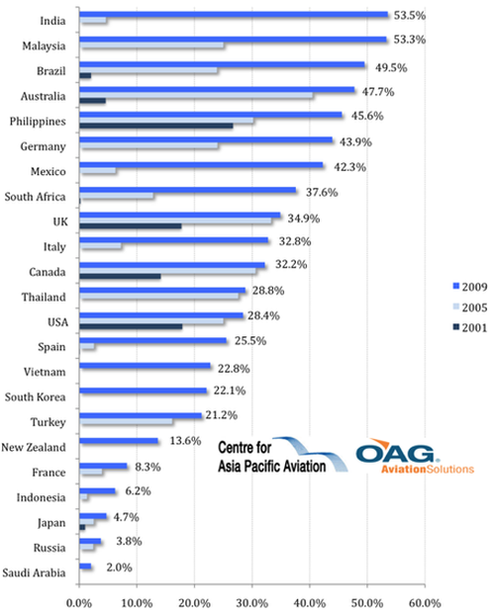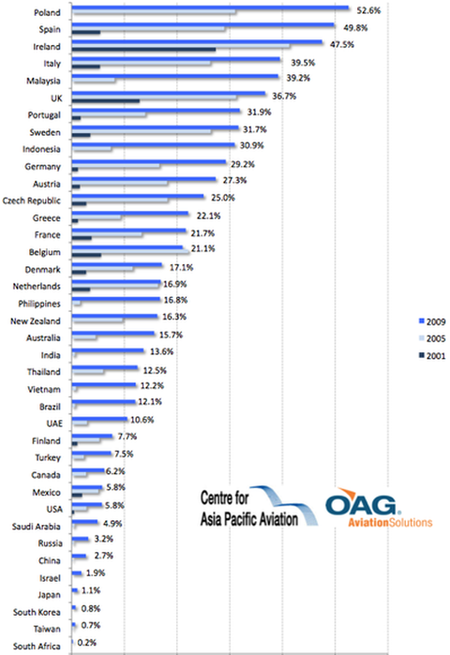Unstoppable and irreversible: LCCs spread around the world: regional round-up
The US domestic industry, which in 2001 accounted for over 34% of global airline seat capacity, has reduced in 2009 to approximately 24%. This is not so surprising in itself, as the developing world markets begin to expand; but to see the actual decline in real terms over this period is surely shocking.
Moreover, because of the vast size of the US market, its decline goes some way to accounting for the stabilisation in full service operations that we see globally. Here, while full service airline seat numbers have remained static over the eight years, low cost airlines have more than trebled, now exceeding well over 20% of all global seats.
LCCs vs Full Service Airlines total seats (millions): 2001 to 2009*
LCC worldwide capacity (seats) share (%): 2001 to 2009*
From a mere 7.8% in 2001, the proportion of global seats provided by low cost airlines is now 22% - an extraordinary growth story.
Unsurprisingly the growth story varies by market, depending on size, maturity and features such as international vs domestic operations. One thing they do have in common is that the vast bulk of new entry and of market expansion by LCCs has occurred this century. The full torrent of change is even more recent than the global impact of the internet.
This extract is from the 'Spread of LCC operations around the world' section of CAPA's Global LCC Outlook report, available for free download at: centreforaviation.com/lcc/report
North America: Late LCC uptake in the US; yield shock, then demand shock
Somewhat remarkably in retrospect, the US was actually a relatively late convert to the LCC model, at least on a large scale. The domestic market was deregulated in 1978 and, in theory, there was no restriction on new airline entry. Early attempts, like PEOPLExpress and New York Air, were relegated to the ignominy of a controversial merger in Frank Lorenzo's Continental Airlines.
Throughout the 1980s and -90s, apart from a series of fleeting entries and exits, the low cost model failed to gain traction. Much of this was due to the resilience of the incumbents so long as yields remained high; only a brief period after the 1st Gulf War saw LCCs flourish, as legacy airlines stumbled with slackening demand. But they recovered quickly as the economy improved.
Thus, despite global adoption of the "Southwest model", albeit often heavily modified, it was not until the milestone Chapter 11 bankruptcy of United Airlines, that the major domestic US airlines started to recognise fully that the steeply lower unit cost profiles of home-bred LCCs were irreversibly reshaping travel demand.
After nearly a decade of soft expansion, as economic growth accelerated after the first Gulf War, the full service airlines had seen no need to slash costs, so long as yields were strong. They retained enormous market power and were often able to snuff out budding new entry, using capacity and pricing strategies that, at best, skirted anti-trust laws. Some toyed with their own low cost subsidiaries, but cost cutting at the mainline carrier was usually not much more than nominal. And, in any event, while they were making profits it was very hard for them to convince their well-entrenched unions that reductions were necessary.
It took the yield shock of the IT bubble bursting in early 2000, then followed by the post-September 11 demand shock, for the unit cost differentials with emerging new LCCs like JetBlue, Spirit and an expanding AirTran to be recognised as indicators of an industry in metamorphosis.
As the Government Accounting Office noted in a report in 2004, this was a different breed of LCC:
"The emergence of well-capitalized low-cost airlines has also been a significant challenge (to the full service industry). Although earlier new entrant airlines quickly disappeared, this recent group is better capitalized and offers a good overall product. Between 1998 and 2003, these low-cost airlines increased their presence in the 5,000 largest city pair markets (e.g., New York - Boston) from 32 to 46 percent and increased overall market share of passenger enplanements from 23 to 33 percent."
New market expansion by these lower cost operators in the early years of the 21st century was driven by a strong economy, cheap credit, cheap fuel, aircraft aplenty and low entry barriers. The tech boom had also provided US consumers with low-priced, high-speed internet access and the innovative LCCs quickly exploited the transparency of this distribution opportunity to the full.
Travel agents, still residually influential in full service distribution, had never been a large part of LCC operations; now even the call centres were dispensed with, both widening the carriers' market visibility and further reducing their costs. And, driven both by consumer softening and the impact of the new LCCs, major airlines cut back heavily on capacity. In the 27 months to 31-Dec-2003, The seven low-cost airlines increased seat capacity by 26.1 percent during the same period that legacy airlines cut capacity by 12.6 percent, but total operating costs for low-cost airlines increased by a more modest 9.8 percent, or a little more than $1 billion."[1]
This period from 2002 to 2007 offered entry conditions as fertile - and pivotal - as they will ever be.
As the new entrants proliferated and expanded, they more frequently bumped up head-to-head with the legacy airlines. Competition quickly now arrived on most of the main routes the full service operators operated, thus progressively stifling every refuge they had previously possessed.
Then, more recently, as large LCCs themselves started to go head to head, the climate on those routes grew fiercely hotter.
But in the meantime, one of the most remarkable market shifts has occurred. Today, approximately 19% fewer seat are being flown in the US than there were 9 years ago. This must surely be the only national market which has contracted overall.
US LCCs vs Full Service Airlines total seats (millions): 2001 to 2009*
US LCC domestic capacity (seats) share (%): 2001 to 2009*
This contraction is partly testimony to an enforced discipline to reduce capacity and goes part way to explaining the improved profitability of the airlines during this period of strong economic growth. As things gradually recovered following September 11, the financial straits they had suffered made full service carriers more circumspect about adding new capacity - and, even if they had wanted to, their balance sheets often did not permit. Load factors improved as a result.
The domestic industry's 10-11% load factor increase for 2008 over 2001 has done wonders for the bottom line - while simultaneously reducing the industry's carbon footprint!
US carriers international and domestic passenger load factor: 2001 to 2008
Canada
Canadian domestic airline deregulation began in 1979, in sympathy with its neighbour to the south and the market has been completely deregulated as to market entry, services and pricing (but, like the US, with tough restrictions on foreign ownership) since 1988, when Air Canada was privatised (although recently bailed out when it looked as if it would re-enter bankruptcy protection).
After the collapse/acquisition of Canadian Airlines by Air Canada in 1999, the resulting near-monopoly was subsequently challenged in the marketplace by a genuine LCC, WestJet.
Air Canada developed various strategies to combat WestJet's expansion, including low cost subsidiaries of its own, but today the LCC occupies approximately 32% market share, after expanding out of its western Canada base.
(LCC capacity share in Canada reached as high as 36.5% in 2004, prior to the failure of Jetsgo, which served 19 destinations across Canada, 10 destinations in the United States, and 12 scheduled weekend-charter destinations in the Caribbean in Mar-2005 and the decision by Canjet in Sep-2006 to cease scheduled flights, but continue to operate as a charter airline).
Canada LCC capacity (seats) share (%): 2001 to 2009*
Mexico
LCCs are a relatively new concept in Mexico, and the movement was almost short-lived owing to the 2008 spike in fuel prices and the subsequent global economic recession. But, in a tighter economy, LCC seats have surged to account for over 42% of total domestic capacity this year.
Several airlines were grounded for lack of capital and credit, high taxes, safety reasons, and other negative factors and that was before the worst impact of the credit crunch was felt. The onset of swine flu in early 2009, which originated in the country, played a large part in the traffic reductions of around 25% in the three months to end Jun-09.
From nine Mexican LCCs in May 2008, mostly operating into southern and western states in the US, often underfunded, with weak business plans, four remain today: Viva Aerobus, Volaris, Interjet and Mexicana's subsidiary, MexicanaClick. They encounter fierce competition with the two Mexican majors, Mexicana and Aeromexico, along with powerful US airlines. Nonetheless, Mexico still retains one of the highest proportions of LCC operation in the world.
Mexico LCC capacity (seats) share (%): 2002 to 2009*
Europe's LCC surge also occurs in the new century
It is mind-boggling to imagine what would have happened to European travel - and how different its society would be today - if internal air services had been liberalised back in 1978, along with the US. For, even buried under six feet of regulatory concrete, forms of LCCs still forced their way, mushroom-like, through to daylight.
But it was only after the European Union liberalised internal air services in the mid-1990s, sewing the seeds of the revolution, that the new movement began. Yet there too it was not until these same factors from 2000-onwards also showed the potential of the LCC that things really took off.
In Europe there was one big difference from other markets. Despite (or because of) the strict regulatory barriers designed to protect flag carriers, a regulatory escape valve had permitted the expansion of package "charter" operations. This concept began in earnest in the 1960s, when summer charters (with bulk ticketing) also started to dominate trans-Atlantic travel, at first mostly to and from the UK.
(These differed from the common intra-European model in not having to include any ground component; their differentiator was that passengers typically had to have a common interest - such as students or clubs - a limiter that was increasingly abused.)
The air travel components of the intra-European operations had much in common with LCC philosophy: cheap prices, slim margins, single class, high density seat configurations and high utilisation of aircraft. To protect the "individually ticketed" flag carrier services, these charters were however only permitted to sell package holidays - mainly for summer stays in the Mediterranean - and there was no separately published airfare component. The companies selling the holidays were vertically integrated, organising each step of the air and surface transactions; for them the aircraft were only one part of the production chain.
One point of operational difference was however that they often operated longer sectors, of 5 hours and more, typically from the cold north to the warm south - and typically used B767 and B757 equipment when these aircraft appeared. Consequently they had extremely low seat costs. They operated on knife-edge margins. As one operator confided, their profit came from "duty-free sales from the last two rows of seats". So, when the EU removed duty free sales, the charter operations became even more precarious.
Quasi-LCC operators emerge
But water flows downhill. Popular demand will generally find an outlet, especially where one or two governments were prepared to look the other way. The UK was one. Second tier national scheduled airlines, such as British Caledonian, were allowed to operate what were technically package charters on non-holiday routes, to London for example, where the ground "accommodation" package nominally consisted of perhaps six beds in one room. Passengers would often not even realise that there was a ground component at all. The difference: these individually marketed and ticketed "charters" charged less than half of the parallel fares the legacy airlines asked on the same routes.
By the 1980s, despite the political efforts of the legacy airlines to prevent the cancer spreading, more than half of all the air passengers in Europe were flying on either genuine or dummy charters. It took the EU to decide to break down the legal barriers in 1993, by removing the power of national governments to restrict airline access on economic grounds, forming European open skies.
A tough initiation for the LCCs: competing at both ends of the spectrum
So, when they arrived in this new open market, the LCCs had to compete at both ends of the spectrum, with the brutally efficient charter operators at one end and the aggressive market power of the legacy airlines at the other.
In this environment the LCC model truly showed its mettle. It quickly upset the legacy and charter companies, leaving both battered, and scurrying to become low cost and direct selling.
One thing that helped the new arrivals was that the full service enemy was half-asleep. Here again the attitude prevailed that the LCC catered to a different sector of the market and, based on assumptions of the yield advantage that full service airlines possessed, the sector would quickly hit a market share ceiling.
But European full service airlines did not comprehend the emerging threat
Quite simply, the low cost model was not understood in Europe, at least by many of the opinion leaders. Thus, for example, a McKinsey & Co report released as late as mid-2003 treated the new wave patronisingly, predicting that, from 2007 onwards, growth of the low fare airlines would slow as they directly confronted more traditional carriers on major routes (as secondary airport options and passenger demand dried up), while charter airlines would remain powerful in leisure markets. McKinsey also expected that traditional and low fare airlines would then coexist in some form of equilibrium, because "the product offerings differ significantly".
This would, said the report, ensure that the LCCs' European market share only grew from the then 7%, to be capped at 14% by 2007. In fact it was more than double this level by 2007 and is today around one third of the total, still growing fast, accelerating as the legacy airlines cut back.
Within Europe LCCs vs Full Service Airlines total seats (millions): 2001 to 2009*
Armed with this thinking, full service airlines could be forgiven for underestimating the LCC threat at that stage and this left full service airlines unprepared. Some, like British Airways, confronted by both easyJet and Ryanair in their backyard, did however recognise the necessity to respond in kind, even if the implementation of its LCC subsidiary, Go, was not successful. All took some steps to reduce costs, but the baggage of decades, together with a certain complacency, did not allow the urgency that was - in retrospect - then needed. Again too, as long as the airlines were profitable, their powerful unions were unwilling to accept the pain which went with substantial cost reductions.
EU expansion aids growth
The expansion of the EU's borders in 2004 and 2007 certainly helped in the new model's expansion, both of new airlines and of new routes, as well as the continuing rapid market share growth. And, as cheap one way fares, transparency, internet distribution and dynamic packaging became the norm, even the very low cost charter airlines were also either subsumed into the type, or simply folded.
Even as late as Aug-2005, another report by McKinsey still focused on the yield premium that the flag carriers possessed (implying that a higher cost base was acceptable) over airlines like Ryanair. This was read as further evidence that they catered to different market segments - an assumption that, even if it had been correct four years previously, was a little like assuming that the bull over the road would not stroll across into the cow paddock. There was no longer any regulatory fence there to prevent them.
But, unlike the US, the European LCC market has continued to grow.
LCC capacity (seats) share (%) Within Europe: 2001 to 2009*
Eastern Europe
With the exception of Russia, where the domestic market is heavily distorted by politico-commercial intervention, eastern European countries are moving to embrace LCC operations, reciprocating the inroads being made into their markets by the EU's low cost airlines. Failing flag carriers have caused several to retain protective regulatory positions, but as the flood of LCC service spreads through, so there is a flow-on impact which is softening attitudes towards new entry. Eastern Europe retains the biggest LCC international LCC penetration of any region worldwide.
Hungary's Wizz Air has been one of the more aggressive of the EU low cost operators flying eastwards. Non-EU Turkey offers the largest potential in this region, already with a substantial domestic LCC market share of above 20%.
LCC penetration to/from major regions (%): 2001 to 2009*
Southwest Pacific
In the South Pacific, Australia and New Zealand embraced domestic deregulation more than 20 years ago, but it was not until the beginning of this decade that the market power of the legacy incumbents was sufficiently challenged to allow carriers like Virgin Blue to take root. Since Qantas established its own low cost subsidiary, Jetstar, Australia now has over 50% of its domestic service provided by LCCs and tiny New Zealand has two LCCs competing head to head with its own born-again legacy flag carrier.
The South Pacific island nations, one of the few regions in the world where a genuine multilaterally agreed international open skies regime is now in place, has witnessed an especially significant turnaround, as heavy loss-making small island flag carriers gave way to either joint venture LCCs or opened up to foreign operations from the two larger countries of the region.
Southeast Asia
Southeast Asia's LCC operations began with domestically deregulated Malaysia, where fast growing new entrant, AirAsia quickly expanded into regional international markets.
Singapore Airlines joint ventured with private equity to establish a part-owned subsidiary, Tiger Airways. Thai Airways also established Nok Air under a similar scheme. But Asia's international entry regimes (formally at least) remain restrictive and a much-touted ASEAN multilateral liberalisation agreement is slow in being implemented, although if it is followed through, should allow open skies among all Southeast Asian nations by 2015. That said, its phased implementation regime is playing an influential role in edging the respective nations towards greater liberalism; Singapore and Malaysia for example had this year effectively opened their respective skies.
Indonesia, with a population of over 200 million and a vast archipelago, joined in domestically with fervour, while remaining protective until very recently on international access. Vietnam, also with a booming and large domestic market has jumped high from a standing start in the past three years.
South Asia (India)
Likewise the Indian market saw unparalleled expansion of the sector, moving from 4% LCC presence in 2004 to over 50% market share today, as most entry requirements were removed. Between Jul-2004 and Jul-2007, the domestic market grew by an unprecedented 150%; here the splintering of the market has led to inevitable consolidation which is now helping the industry work its way back to profitability. There has been a price to pay for this extreme shift, but the system is stabilising once again, with some consolidation occurring.
Overall, South Asia (which India dominates) has the highest proportion of LCC penetration of any region worldwide, at over 46%.
LCC penetration within major regions (%): 2001 to 2009*
Asia Pacific
Meanwhile, outside the European Union and North America, this phrase was repeated without fail, as low fare startups threatened to enter local and regional markets.
In many cases, the market was in fact "different": in Southeast Asia, the Indian Subcontinent and Oceania, the problem of genuine international operations often had to be confronted (where "genuine" means overcoming the restrictions and protectionism that go hand in glove with cross-border operations).
Perhaps more surprised at how consumers resembled their global counterparts were the incumbent Asian full service airlines. Without exception they believed that their renowned low seat-cost widebody capability would counter even the improved narrow-body costs of the new entrants. But they had not factored in the opportunities to fly new routes, to offer frequency on existing routes and to offer new aggressive forms of pricing. Nor that governments would quickly start to see the political and economic benefits they could stimulate.
LCCs have quickly risen to account for almost 16% of intra-Asian seating capacity.
LCC capacity (seats) share (%) Within Asia Pacific: 2001 to 2009*
Within Asia Pacific LCCs vs Full Service Airlines total seats (millions): 2001 to 2009*
North Asia; a market ready to bloom
The most significant outstanding market where liberalisation is appearing at only a miserly rate is Northeast Asia.
China, despite having a vibrant domestic market, still effectively prohibits low cost airlines from operating domestically (with central controls over pricing, distribution, fuel aircraft purchases and many other operational areas).
South Korea has powerful incumbents, both in terms of market control and political support and Japan, despite attempts by its specialist regulators to support open skies among the three major countries of the region, is subject to very high costs and dominance by its two major airlines, with whom most service provision lies. Fledgling LCC operations exist in each country, but their existence is tentative.
Both Korea and Japan also have very efficient and subsidised fast rail, which makes domestic LCC establishment difficult, and international access regimes are still generally capacity and frequency controlled (and often price controlled too). Any new airline must operate domestically for a period, before being permitted to operate internationally, giving the full service carriers the jump in establishing their own subsidiaries.
In many ways this region's regulatory regimes mirror the global restrictiveness and interventionism of the 1970s. Even Japan Airlines, privatised for two decades, has recently been delivered a JPY100 billion[2] bailout loan by the government, which has established a committee to oversee the restructuring of the flag carrier.
However, each of the three countries is now permitting inbound operations by the Southeast Asian LCCs, a factor which is steadily influencing consumer behaviour, a force which will accelerate change in government attitudes. The triangular market between Japan, China and South Korea is a potentially massive one; the Centre has estimated that passenger numbers could grow rapidly to an additional 300 million annually, were there no limits on access. But this is more than a merely commercial equation, given the always important international differences.
But liberalisation is coming, on the back of socio-economic issues; Mainland Chinese and Taiwanese airlines are now able to operate non-stop every day of the week between selected city pairs, with capacity and designation restrictions, a move of both symbolic and commercial importance.
Japan under a new administration and with JAL in dire condition, may influence new moves in one way or another, hopefully towards liberalisation. This could tip the balance relatively quickly. A reconstruction of JAL is likely to spawn a low cost subsidiary (if it doesn't, the airline is in even more trouble than it appears). This will have to be matched by All Nippon Airways, its main rival; ANA already had plans to establish one, but has placed the project on hold temporarily.
And, with genuine LCCs emerging in Korea, together with a renewed Japanese popular fascination with all things Korean, there are the seeds of rapid growth as early as 2010, particularly as more airport capacity comes on line in Tokyo and Shanghai. For each side, the economic rewards on offer, especially at regional centres, are potentially vast. It would not take long for China to join that party, at least freeing up regional points to international service from its near neighbours.
Other Emerging Markets
Similar international regulatory problems face South American LCCs seeking to expand beyond their borders. Regulatory controls still permeate the region, as flag carriers predominate. Only Brazil, with the region's success story, GOL, has fully embraced LCC operations, now with David Neelemann's Azul also gaining a 4% market domestic market share. The major economy of Argentina to the south is still stuck in a time warp, protecting an ageing Aerolineas Argentinas. GOL flies to several countries, but beyond that, there are few examples of successful low cost operations.
Several Central American states, more influenced by North American economic theory and direct air services, particularly NAFTA-member, Mexico, have been more ready to relax entry requirements. As noted above, Mexico has had a highly competitive and fast growing industry as a result, although rationalisation is now occurring.
Sub-Saharan Africa
In Africa, apart from the northern, Europe-facing shores, international operations are difficult still, although LCC operations abound in South Africa. Rekindled flag carriers like Kenya Airways and Ethiopian Airlines offer some hope for Southern Africa's aviation development, but so far, outside South Africa, there is little LCC activity and plenty of protectionism. By contrast, over a third of domestic seats are on LCCs in that country, led by Comair/Kulula and SAA subsidiary, Mango.
Almost without exception, the relentless tide of low cost airline operations has swept across the world, all of it in the last few years, catching most unawares. These other markets are dealt with region by region in detail in Part 2 of this report, but it is useful to compare the respective market shares here. With very limited exceptions, there was next to no LCC market share in 2000.
Historically one of the most conservative regulatory regions in the world, the intra-Middle East markets have enormous potential, once relaxation is permitted. The UAE, with its open skies policies, has done much to awaken the recognition of the potential of a more open system and - largely thanks in the first instance to the India-UAE market - Air Arabia has been able to do here what AirAsia did in the Asia Pacific region. Now, other gulf states are following suit and other countries are moving in the same direction - at differing speeds.
North Africa, quickly being linked into the Gulf LCC expansion, is already well serviced by European LCCs flying tourists there, but internally there is room for liberalisation, as flag carrier protection remains the controlling factor.
The EU is active in spreading liberalisation has established a programme of "open skies" agreements with non-EU members whose potential is significant. The so-called Euro-Mediterranean Air Transport Agreement is part of the process of creating a wider "Common Aviation Area with the EU's Eastern and Southern Neighbours" by 2010. Negotiations began with Tunisia in Dec-2008, and Algeria, Lebanon, Georgia, and Israel are also reportedly in discussions. A horizontal agreement was signed with Jordan earlier this year.
Country Performance
Domestic markets
The emerging markets have shown the largest increases and the highest proportions of LCC capacity, the most extreme example being India, where over 50% of the previously underdeveloped market has been assumed by low cost airline operations.
But Australia and Germany also feature high on the chart, despite already being relatively mature markets.
Of the countries with substantial land-masses, France distinguishes itself with a remarkably small, 8.3% LCC capacity share
Domestic LCC penetration: Major markets#: 2001 to 2009*
International markets
Unsurprisingly, European LCCs, along with some Asia Pacific airlines, have been most adventurous in their international excursions. In Europe's case this is partly a matter of following in the tracks of the former charter airlines to adjacent holiday destinations, as well as the opening up of eastern European states.
The US and Canadian carriers have to date been most cautious in venturing beyond their home borders, suggesting why so many are now eyeing the opportunities as their domestic climates become uncomfortable. Several of the short haul city pairs in north and central America still offer good yields, dominated by full service airlines, suggesting the potential for growth as new entrants penetrate them.
International LCC penetration: Major markets#: 2001 to 2009*
Unstoppable and irreversible
Despite the vast cultural differences and economic backgrounds, somehow, the attraction of very low fares, new alternative routings and frequencies, all based on a low cost mentality, and providing airline choices has ensured that low fare airline market shares blossomed wherever they have operated.
Even in the massive headwind in 2008 caused by a spike in fuel prices, the juggernaut somehow storms ahead. On international routes, its airlines are more vulnerable in many ways, having to confront the ingrained protection that almost every long-established full service airline receives from its governments, preventing market access, who wink at predatory practices by incumbents and, even today provide bailouts and "loans" to help some flag carriers through the current downturn.
Domestically and within the EU, different problems exist, but they are more market-related, albeit threatening to get worse; government taxes and charges are too easily imposed and have a disproportionate impact on lower fares, diluting the LCCs' power to stimulate demand. Air traffic control infrastructure and airspace controls typically also have a greater cost and operational penalty on LCCs, diluting the low cost advantage. And, as many in the industry observe, there are simply too many competitors in the major markets.
But, while some must fall by the way, this movement is unstoppable and its legacy irreversible.
Download the full Global LCC Outlook report at: centreforaviation.com/lcc/report
Comment at our blog: https://centreforaviation.com/lcc/blog
[1] at p5
[2] With much more to come
